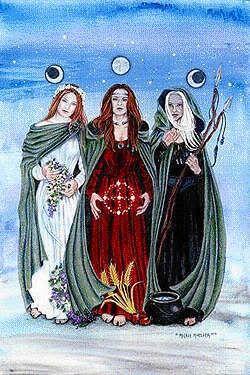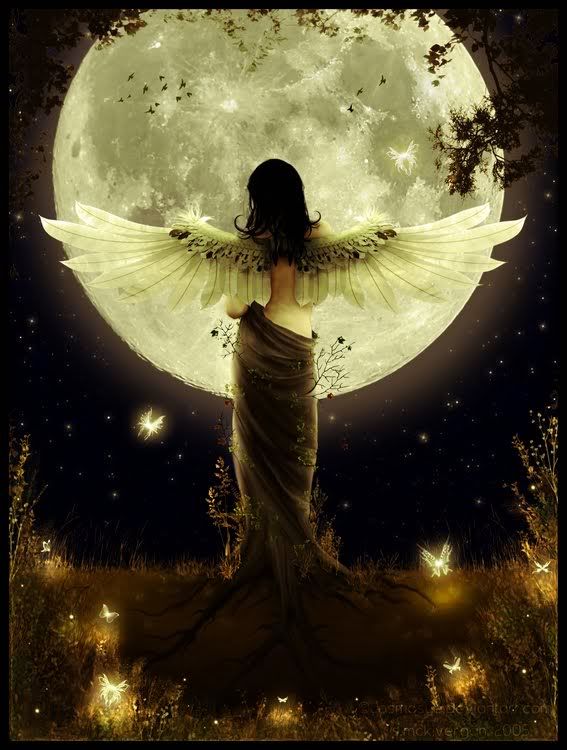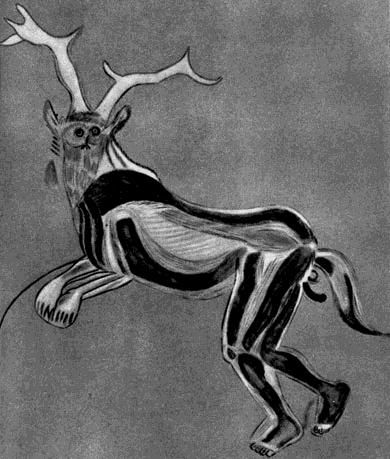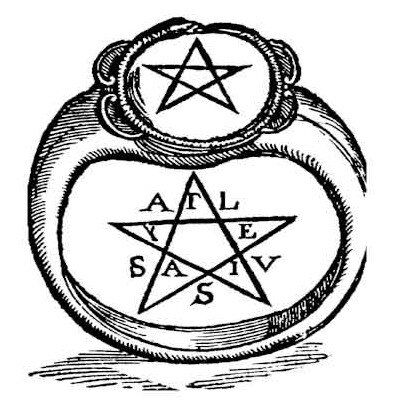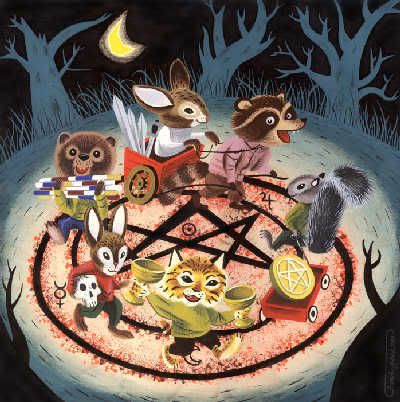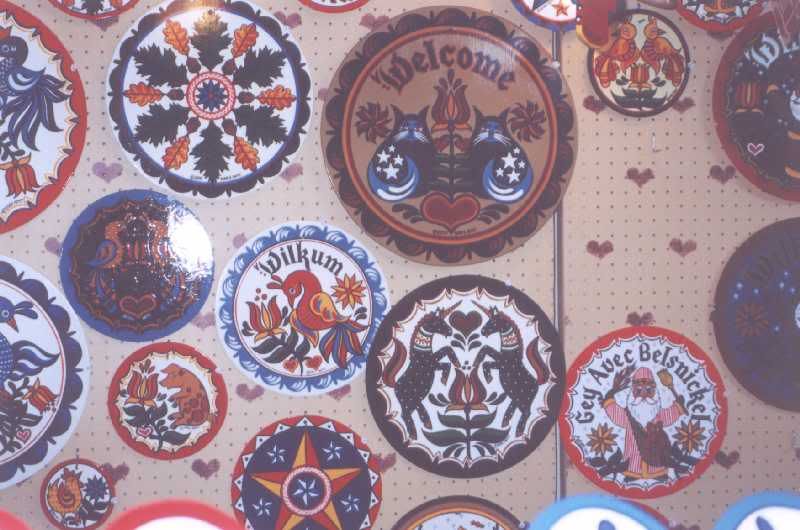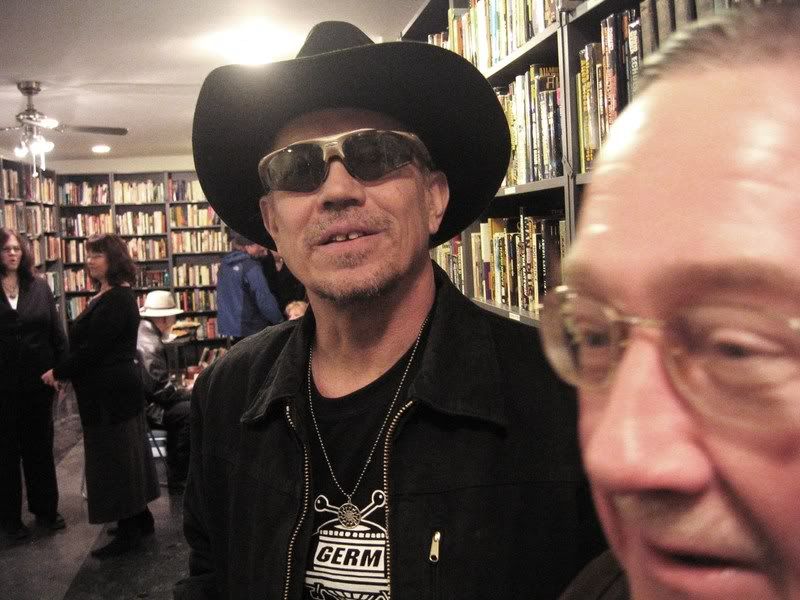
1) Greetings Hunter. To begin please introduce yourself and give the readers some info on your roots in Heathenism.
Heil Georg! I am a Heiden Hexologist, owner and creator of the Hex Factory Gallery in Philadelphia, which is dedicated to Germanic tribal art and Pa German Hexology. I have authored numerous essays on the subject of the new Heathen Hexology and magic plants and the book, The Backdoor Hexologist, Volume One. I am the founder of the online site www.Zaubereigarten.com where I have interviewed the avante garde of the Pa German magical traditions known as Hexerei. I was born and raised in the heart of Pennsylvania Dutch country, Berks County, PA., I began painting hex signs on barns at an early age. I am an avid Netherland Dwarf rabbit breeder, entheologist, and father of four.
My roots in Heathenry are in Berks County, Pennsylvania or Barricks Kaundi in Pennsilfaania in Deitsch, a German dialect spoken there. Der Deitsch Volkskultur where I grew up is the basis for my reanimation of our Folk ist prechristian beliefs and customs. I prefer the Deutsch, 'Heiden' to Heathen which is Anglo Saxon. Berks County is ground zero for Hexerei in the New World. My area of interest has always been Hexerei, or Germanic witchcraft, which is not directly associated with any organized or institutionalized form of religious practice but rather a flexible, individual approach to folk magic, specific to a folk culture in this case the Pennsylvania Germans.
2) Who were the individuals that were the most inspirational in your beginnings with Hexology?
Well let me preface the response to this question by stating that the frequency of Hex signs or Barnstars is the greatest in Northern Berks County then anywhere else in North America, maybe the world. I grew up on a farm near the small town called Virginville on the Maiden Creek which later contributes to the Schuylkill River which runs to Philadelphia. The farm was on the Saucony Creek a Lenni Lenape word for 'little bear' The Barnstars were on all the barns on all the farms. Locally, Milton Hill was the source of most of these barnstars. The great Hexologist, Johnny Ott of Lenhartsville was a couple of miles downstream, where he had the Deitsch Eck Hotel and where he also painted his famous Hexes that he and Jakob Zook of Lancaster made famous. Johnny sold his Hex business to a Johnny Claypoole who was from Upper Darby in Philadelphia, but moved up into an old stead just outside of Lenhartsville. I went to school and ran with his sons engaging in country youth activities such as skinny dipping in the Maiden Creek and jumping off cliffs into quarry lakes. We also drove old Dodge pickup trucks from the early fifties that we bought very cheap and fixed up. Eric, one of Johnny's sons now has the Hex business in Berks County.
3) You originally were from Berks County. Then you lived in Brooklyn and now Philadelphia. What was your interest in moving to Philadelphia?
Philadelphia was the portal for most the German immigration into North America for centuries. My ancestors and yours entered the 'new world' here in Philadelphia. During Colonial times, so many Germans came to Pennsylvania, Ben Franklin called them the Palatinate Moors. My arrival to East Kensington which still today retains a very Germanic population was not by chance. My own spiritual evolution brought me to the source of our Folk to this their new Heimot. Germans love to farm and SE Pennsylvania including my Berks County has 'die besten Ackerboden' I however find the innercity as the new frontier and the retaking of old neighborhoods which our folk built and rebuilding them has been both rewarding spiritually but also materially. I see the future in the city, life there is more efficient less reliant on the petroleum fueled monokultur which has alienated us from our true kultur and has bankrupted us. The culture of the car is growing to a close despite frantic efforts by our governments and world financial players to the contrary.
4) Please explain what Hexology is and also elaborate on it as a magical practice.
Hexology is actually a term invented by Jakob Zook and Johnny Ott in the very late 1940's. The Zook/Ott collaboration has made the term, 'Hexology' internationally famous. It came about at a time after the War, when America was booming, as in Baby Boom. Car Culture was really taking off. Families went places in the car for summer vacations. Lancaster County in Pennsylvania tapped into this tourist trade which continues to this day. The PA Folk Festival in my Hometown of Kutztown, in Berks County started. As we are today, back then people were fascinated with Pa German Barnstars. Ott designed them and painted them on round disks. This differed from the traditional practice of painting them directly on buildings or furniture. Zook took Ott's designs and silk screened them onto masonite disks for the tourist trade. Ott became a self styled Professor of Hexology as Dr Johnny Ott, and there you have it. Hexology was then a commercialization of the darker practice of Hexerei, or as it was called by the Deitsch (Pa Dutch) Hexerie or the Jinks, sometimes called Pow Wow magic.
5) You are a practioner of magic plants. Tell the readers more about this and how it differs from herbalism.
My knowledge of plants contrasts in many ways with herbalism. Knowledge of 'die Blantz' is essential in the Pa German kultur. We hear how the European settlers learned about plants from the so called 'indigenous' or Indians. However, the knowledge transferred went both ways. I recently procured a variety of snow white sunflower seed from a tribal seed bank in Arizona from the Tarahumara, a tribe made famous in, "The Peyote Dance," a book by Antonin Artaud. However the real source of the seed variety came from the Tarahumara's interaction with the Mennonites who settled near them in the Chihuahua desert which they turned into a garden. This is what our Folk do. We grow better then anybody including the so called 'Indigenous'.
Anyway, my 'herbal remedies' are far different then the Herbalists. Hexerei uses Power Plants or Plant Teachers to cure the spirit of the patient.
6) How does your usage of magic plants relate to magical symbols?
The Deutsch term is Zauber or magische. There is power in the words, how they are spoken and spelled, the Icelandics call it Galdr, the Deutsch, gesprochen Magie. The connection between die Blantz und die magische Zeichen; the answer is simple, plants have been used in folk art since the neolithic times. Powerful plants and especially trees populate Germanic tribal 'art' The essence, the spirit of the plant is represented through a stylization of it. The stylization is really just a symbol that invokes the power of the plant, visually. My own contribution to this process has been to replace the Christian plants and flowers in the traditional Pa German Folk art seen in Fraktur and Hexology with the Heiden magic plants. For an example, tulips are used as symbolic of the resurection of the Christ. I will substitute them for my own stylizations of Datura Stranomium, 'Geilskimmel' and Black henbane or 'Niger Bilsenkraut'. These two are power plants for the prechristian Germanic tribes used by the Volvas for divination. We find henbane seeds in the burial mounds of these exalted 'Hexes' In post reformation Germany, usage of Black Henbane seeds would result in a terrible death, being burned at the stake. More 'witches' were exterminated by Protestant Germany then anywhere else. The commonly held belief that witches fly on broomsticks comes from the practice of female 'Hexes' using an ointment of fat and Bella Donna to grease a broomstick which they stradled to absorb the Atropine a powerful hallucinatory agent through their genitalia.
7) What is the relation between sex magic and Hexology?
Pa German Sex Magic is a way of life. It is in fact a way of living and survival. On the farm, success is gauged by the ability to reproduce plants and animals and children. In a sense the farmer is a sex magic zauberer, a f*****g machine. The feminine counterpart is the the nourisher, the source of life, the goddess, the woman, the Hex, the repository of charms, the magical creature, the river of life.
It is my personal view that the Pa Deitsch are descended not from the apes but from certain flowering plants. This is evident by the usage of their Hexology, their 'creation myth' so to speak.
8) Explain the difference between Asatru and Germanic Witchcraft (Hexerei).
Asatru is a religion of contemporary Icelandic Heathens which has spread worldwide as an alternative to other institutionalized religions such as the Monotheisms. This Icelandic prechristian tradition has the advantage of a complete written legacy in the Eddas and other texts.
Germanic Witchcraft or Hexerei is a general term but it is just that, witchcraft. Witchcraft, generally feared by the Christians is neither black or white, evil or good. It is just the acquirement of personal magical power. This magical energy is always much more powerful if used positively. Cursing is actually very easy to do, but it never really ends up well for the one who has done the cursing. The result has a boomerang effect, and when the target determines the source which is usually pretty easy, the malicious energy is simply returned to the sender usually in a much more powerful form. This is primitive stuff, practices that have existed since before prehistory. Hexerei can be employed through everyday means, cooking, humor, sex, business, child rearing, hunting and fishing. Using an intention to acquire a desired result is just natural, be careful what you wish for.
9) You mentioned to me before about the Pennsylvania Germanic roots of Blues music. Can you tell us more about this. Most seem to believe that Blues music's origin is "African American."
I think what you are referring to is my statement that Pa German Hexology is similar to the 'Blues' because virtually anybody can do it (hexes). I've found that the public's interest in making them is at least as great as their viewing them or learning about them. I've done quite a few workshops with people of all ages most recently with children for the Hexenkinder Show at the Hex Factory with O. Henrietta Fisher, and it is always a big hit. Similar to playing music, practice making Hexes is essential. It is useful to learn the basic designs first before moving on to more elaborate ideas.
10) Another subject relating to Germanic magic/witchcraft is called "Hoodoo." Could you explain what this is exactly?
Well Hoodoo is not strictly a Germanic form of sympathetic magic. It is very American. It is most commonly recognized as a southern form but its roots are actually very Appalachian. The German, Scotch, Irish pioneers and settlers that moved through Pennsylvania to the South and out West took their unique ways of effecting their world. Hoodoo was practiced in PA. Hidden or buried 'intentional' objects would typify this practice. Jack Montgomery, Lee Gandee's student has published his book, "American Shamans" and he has a more 'Hoodoo' bent which is appropriate for his Kentucky neck of the woods. Orva Gaile Clubb is another who is very knowledgeable in this form. She correctly sees this as Hexerei and she has a very unique perspective being raised in western Maryland on the farm just below the Mason Dixon line. I will hopefully have her interview up shortly on Zaubereigarten.com . Hoodoo is an American form of the Caribbean Voodoo, or the Brazilian, Makumba. It is interesting to note that Voodoo scholars have great interest in the Pa Deitsch grimnoir, "The Long Lost Friend" published by Hohman in Reading Pa, 1820 as Der Lange Verborgene Freund. It makes extensive usage of the Sator Rotas magic square. Up until the 1930's the State of Pa issued licenses to practice Pow Wow magic, another term for the Pa German Hexerei.
11) I understand you learned about Kabbalah through a Rabbi friend of yours while living in Brooklyn. Could you please explain more of your friendship with this gentleman?
Yes, living thirty years in NYC certainly gave me a positive insight into Judaism. The basics of Christianity are very much from Judaism. Terms like, congregation, pentecost, trinity, originate in Judaism which has undergone many changes in its old and venerable history. Kabbalah however is relatively recent, as a powerful form of mysticism. Briefly just off the top of my head, Kabbalah originated not in Israel but in the German Rhineland and Spain during the later middle ages. In Germany, the Jews were employed much as they still are, for their knowledge of law which required an ability to read and write, something the various German nobilities lacked. The Germans and the Jews have always had a very symbiotic relationship. It is an unusual one, even amongst the Pa Germans. The Pa German dialect or Deitsch is remarkably similar to Yiddish. Both are lower German dialects. When Martin Luther translated from the Latin, the Bible which was subsequently published for the first time and is known as the Gutenberg Bible, he fixed what is known today as high German. Many other German dialects still exist.
Anyway back to your question, Rabbi Joshua Saltzman and I exchanged ideas and information including an intro of Kabbalah on his part. At the time I had 'discovered' that all religious traditions contained the simple concept of a 'tree of life'. The Sephirot as a tree was discussed. Hebrew as a magical alphabet was studied. All magical alphabets include gematria or assignment of numerical values to letter in the alphabet. Hebrew, Greek and the Elder Futhark are examples of magical alphabets. Ultimately our studies led to my conclusion that I could not place any rational reason to. I found myself intuitively unable to absorb the Jewish alphabet and the Sephirot seemed unacceptable numerically and geometrically. I however retained a great respect for the magical traditions of the Jews. Their mysticism is very powerful. In particular the Kabbalistic concept of 'gathering the fallen sparks' impressed me. Joshua had a keen interest in Shamanism and traveled extensively to India, Nepal to further his knowledge in various traditions such as the Sufi. I myself returned to my Pa German roots and have ultimately rejected Shamanism as being a modern day jingoism, a quick fix for a lack of a personal tribal tradition.
12) Do you consider yourself a "Radical Traditionalist"? If so please explain.
Radical traditionalism refers to the renaissance in Germanic 'paganism' I view it through my usual Pa German lense as the reindigenization of my folk. The magical traditions I grew up with in Berks County are the legacy of our European forefathers. That is our tradition. Revitalizing it, reanimating it and rejecting multiculturalism and the petroleum fueled "monokultur" is the radical part, advanced thinking is being done today by such 'traditionalists' all over the world.
13) Thank you very much for your comradeship, your wisdom, and your time in completing this interview. Any closing comments to share with the readers?
I would say this, there is an energy in the magical signs of our Germanic ancestors. It is very real and powerful. Anyone can participate in making them. In doing so you are tapping into something much larger then mere personal self expression. As I explained to a former teacher and friend, A stream or river has run in its bed for hundreds of thousands of years maybe longer, so it is with folk magic. No one is quite sure how it works, just that it does.
Zaubereigarten (Hunter Yoder's website)
.


